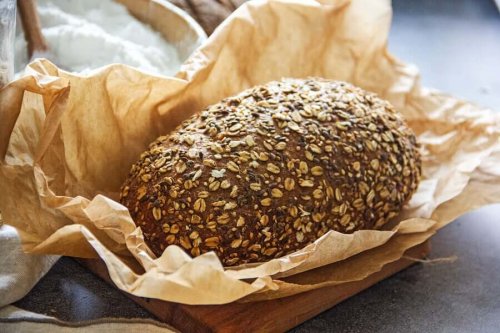Six Tricks to Reduce Your Carbohydrate Intake


Written and verified by the nutritionist Eliana Delgado Villanueva
To lose weight healthily, it’s a good idea to reduce your carbohydrate intake. However, this can become a challenge because many foods that people eat every day contain them. Today, we’ll share some tricks that will help reduce your carbohydrate intake.
Carbohydrate intake affects your health in a big way. An adequate carbohydrate intake depends on factors such as your energy, your weight, and even your blood sugar levels.
What are carbohydrates?
Carbohydrates are macronutrients that many people consume and whose main function is to immediately provide the body the energy it needs to carry out daily physical tasks. They’re very easy to find in everyday foods such as bread, pasta, or fruits.
When you exercise vigorously, your body uses carbohydrates to function. They’re the primary source of energy and are considered the foundation of the food pyramid.
You should also read: Good Versus Bad Carbohydrates: Busting Myths
Six tricks to help you reduce your carbohydrate intake
1. Replace wheat flour with low-carb flours.
Everyone knows that the wheat flour people use for baking usually contains a lot of carbohydrates. However, what not a lot of people know is that there are much healthier alternative low-carb flours that are just as versatile for cooking.
Some of the traditional wheat flour substitutes are made with coconut or walnut. It’s estimated that 100 g of nut flour contains less than 11 g of carbohydrates. Coconut flour contains less than 21 g of carbohydrates. Thus, it’s a good idea to use these alternative types of flours to lose weight.
2. Order vegetable side dishes when you eat out.

Vegetable side dishes can help reduce your carbohydrate intake without having to cut them out of your diet completely. In addition, they’re low-calorie, nutrient-rich alternatives.
Most restaurants usually have many vegetable side dish options on their menus. Depending on what you order, a server may offer you side dishes such as bread, potatoes, pasta, rice, or vegetables. Making a good decision in this regard is very important to reduce your carbohydrate intake.
Choosing vegetables as a side dish is a good way to consume fiber and almost no carbohydrates.
3. Eat eggs and other low-carb foods for breakfast.
Even seemingly healthy breakfasts tend to contain carbohydrates. Eggs are an excellent low-carb breakfast choice because each egg contains less than 1 g of carbohydrates, not to mention that they represent a source of healthy protein that can keep you full for hours.
Ideally, you should learn to prepare eggs healthily. Using a little olive oil to cook them or hard boiling them and serving them with steamed vegetables is one of the many healthy ways to prepare them.
4. Avoid sugary drinks.
The juices and sugary sodas that you can find on the market have a poor nutritional value. Instead, they provide many unnecessary calories.
Drinking them triggers an anxiety reaction in your body that almost always leads you to consume more sources of simple carbohydrates. On the other hand, their high sugar content affects metabolic functioning, and, among other things, causes:
- Increased insulin resistance.
- The tendency to develop type 2 diabetes.
- Increased risk of excess weight and obesity.
5. Try other types of bread other than white bread.

Many ingredients replace refined flours so you can enjoy healthier, low-carb bread.
Bread, which is very common in many people’s daily diets, is, unfortunately, one of the most carbohydrate-rich foods in the world. Also, white bread is among the worst choices when it comes to eating this food because it’s low in fiber and contains a significant amount of carbohydrates.
The best thing you can do is look for healthier sources of grains other than wheat, such as certain vegetables, seeds, nuts, or healthier options such as buckwheat bread.
This article may interest you: The 7 Best Carbohydrates for Weight Loss
6. Replace cow’s milk with other alternatives.
Although milk is nutritious, you shouldn’t consume it if you want to start a low-carb diet. It’s estimated that for every 240 ml of traditional cow milk, the body absorbs between 12 and 13 grams of carbohydrates. Thus, it’s best to find milk substitutes.
Some of the substitutes of cow milk are coconut milk, almond milk, or walnut milk. Most of these products don’t contain more than 2 grams of carbohydrates per serving, representing a significant long-term reduction.
Reducing your carbohydrate intake doesn’t have to be dramatic and unpleasant. The tricks we’ve shared here should help you make this transition simply and healthily. Finally, it’s worth remembering that what you’re trying here is to reduce, not permanently cut out, carbohydrates from your diet.
All cited sources were thoroughly reviewed by our team to ensure their quality, reliability, currency, and validity. The bibliography of this article was considered reliable and of academic or scientific accuracy.
- Slavin J, Carlson J. Carbohydrates. Adv Nutr. 2014;5(6):760–761. Published 2014 Nov 3. doi:10.3945/an.114.006163
- Aune D., Giovannucci E., Boffetta P., Fadness LT., et al., Fruit and vegetable intaake and the risk of cardiovascular disease, total cancer and all cause mortality a systematic review and dose response meta analysis of prospective studies. Int J Epidemiol, 2017. 46 (3): 1029-1056.
- Burton PM., Monro JA., Alvarez L., Gallagher E., Glycemic impact and health: new horizons in white bread formulations. Crit Rev Food Sci Nutr, 2011. 51 (10): 965-82.
This text is provided for informational purposes only and does not replace consultation with a professional. If in doubt, consult your specialist.








